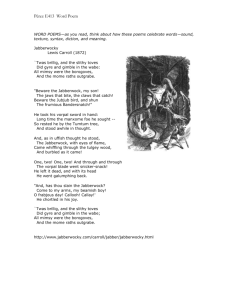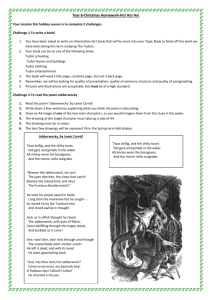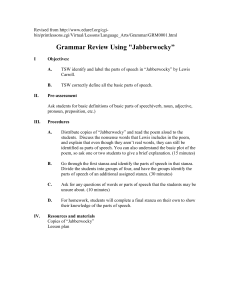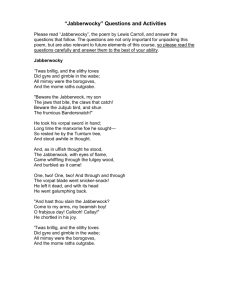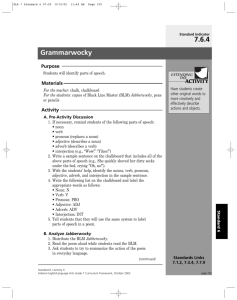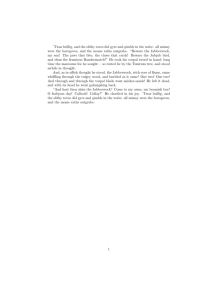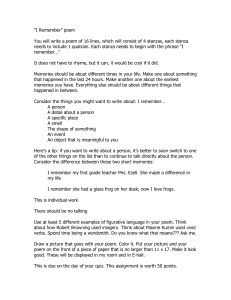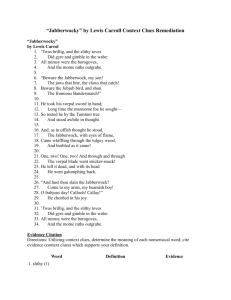harrington_lesson 3 - URI
advertisement
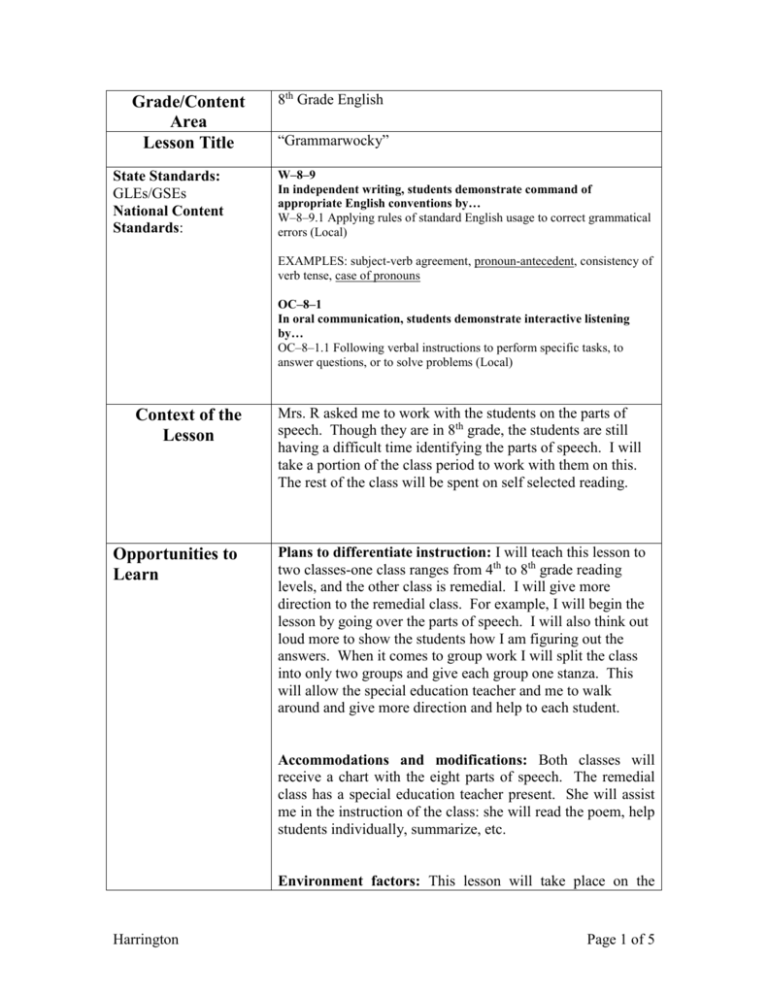
Grade/Content Area Lesson Title State Standards: GLEs/GSEs National Content Standards: 8th Grade English “Grammarwocky” W–8–9 In independent writing, students demonstrate command of appropriate English conventions by… W–8–9.1 Applying rules of standard English usage to correct grammatical errors (Local) EXAMPLES: subject-verb agreement, pronoun-antecedent, consistency of verb tense, case of pronouns OC–8–1 In oral communication, students demonstrate interactive listening by… OC–8–1.1 Following verbal instructions to perform specific tasks, to answer questions, or to solve problems (Local) Context of the Lesson Opportunities to Learn Mrs. R asked me to work with the students on the parts of speech. Though they are in 8th grade, the students are still having a difficult time identifying the parts of speech. I will take a portion of the class period to work with them on this. The rest of the class will be spent on self selected reading. Plans to differentiate instruction: I will teach this lesson to two classes-one class ranges from 4th to 8th grade reading levels, and the other class is remedial. I will give more direction to the remedial class. For example, I will begin the lesson by going over the parts of speech. I will also think out loud more to show the students how I am figuring out the answers. When it comes to group work I will split the class into only two groups and give each group one stanza. This will allow the special education teacher and me to walk around and give more direction and help to each student. Accommodations and modifications: Both classes will receive a chart with the eight parts of speech. The remedial class has a special education teacher present. She will assist me in the instruction of the class: she will read the poem, help students individually, summarize, etc. Environment factors: This lesson will take place on the Harrington Page 1 of 5 second floor of the middle school. Students’ reading and writing levels vary greatly-from 3rd to 9th grade. Materials: White board and markers Copies of the poem Jabberwocky by Lewis Caroll Copies of the eight parts of speech chart Objectives Students will be able to correctly identify the parts of speech of at least ten nonsense words in Lewis Caroll’s Jabberwocky. Students will be able to explain their reasons for the identification of the parts of speech. Instructional Procedures Opening: I will begin by asking students if they speak English. Once they all agree that they do, I will tell them that they can use this inherent knowledge of our language to figure out parts of speech. Directly following this I will read Jabberwocky to the class. When I am done I will ask the students to go through the poem and circle and words that they are not familiar with. Students will circle all the nonsense words in the poem. I will walk around during this and help students notice all the words. Engagement: Once students have finished circling all unknown words, I will write the first four lines of the poem on the board. I will go through each line individually asking students if they can identify the part of speech for each word. When someone correctly identifies the part of speech I will ask them to explain to me how they knew this. Students will voice reasons, such as it describes the noun or it is plural, and defend their answers. When we are done discussing the first four lines I will break the class into groups of students. Each group will receive a different stanza. Students will be asked to determine the part of speech for each unknown word and be able to explain this choice. When students are done, we will go through each stanza as a class. Closure: When we have finished with the poem I will again remind students how they figured out the answers because of Harrington Page 2 of 5 their innate knowledge of our language. I will reinforce their confidence by telling them that they can always use this knowledge to help them learn. Assessment There is no formal assessment for this task. I will informally assess students based on their participation in class and their effort while working in groups. Reflections Lesson Implementation: This lesson worked out very well. Students responded to the wacky poem and tried to constructively participate in class. There were many volunteers. I pushed the students to figure out how and why they knew something was a noun, verb, or adjective. The students were able to think out loud and vocalize their train of thought. Mrs. R informed me later that another class heard of the lesson and was excited for me to go back and teach it to them. Harrington Page 3 of 5 JABBERWOCKY Lewis Carroll (from Through the Looking-Glass and What Alice Found There, 1872) `Twas brillig, and the slithy toves Did gyre and gimble in the wabe: All mimsy were the borogoves, And the mome raths outgrabe. "Beware the Jabberwock, my son! The jaws that bite, the claws that catch! Beware the Jubjub bird, and shun The frumious Bandersnatch!" He took his vorpal sword in hand: Long time the manxome foe he sought -So rested he by the Tumtum tree, And stood awhile in thought. And, as in uffish thought he stood, The Jabberwock, with eyes of flame, Came whiffling through the tulgey wood, And burbled as it came! One, two! One, two! And through and through The vorpal blade went snicker-snack! He left it dead, and with its head He went galumphing back. "And, has thou slain the Jabberwock? Come to my arms, my beamish boy! O frabjous day! Callooh! Callay!' He chortled in his joy. `Twas brillig, and the slithy toves Did gyre and gimble in the wabe; All mimsy were the borogoves, And the mome raths outgrabe. Harrington Page 4 of 5 Harrington Page 5 of 5

